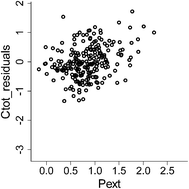Phosphorus availability explains patterns in a productivity indicator in temperate semi-natural vegetation
Abstract
Plant production is a key process in semi-natural ecosystems, affecting resource provision, carbon storage, and habitat suitability for species of conservation concern. There is debate over whether nitrogen (N) or phosphorus (P) limits productivity more widely, and whether the pattern of limitation has been affected by widespread atmospheric N pollution. In a national-scale survey, floristic composition was used to derive mean Ellenberg N score (EN) for use as an independent metric of productivity. Much of the variation in EN within extensively-managed habitats could be explained by bulk-soil properties such as total C and moisture contents, reflecting the axis from wet, organic, infertile soils to drier, mineral, fertile soils. However, this main axis of variation was also explained well by bicarbonate-extractable P stock, and P stock was included in the best 88 of 255 possible models for all habitats, or the best 55 of 255 models for extensively-managed habitats. The stock of mineralisable N was much less well able to explain variation in the productivity metric, particularly in extensively-managed habitats. This suggests that P availability is a more widespread constraint to the productivity of semi-natural ecosystems in the UK than is N availability.

- This article is part of the themed collection: Macronutrient Cycles

 Please wait while we load your content...
Please wait while we load your content...